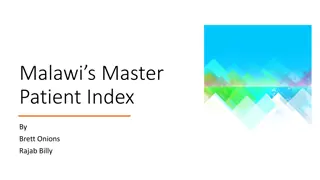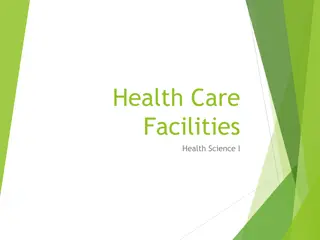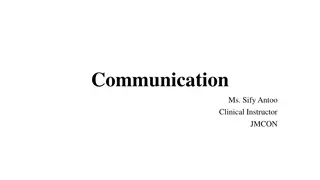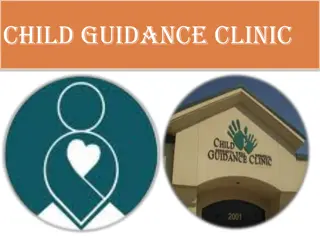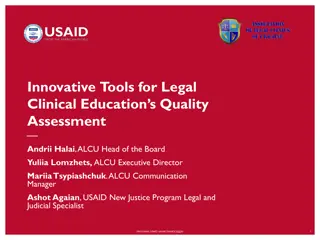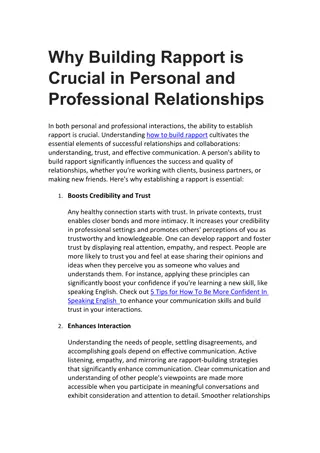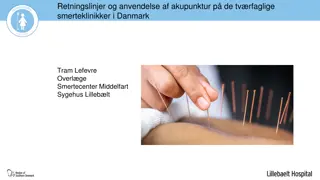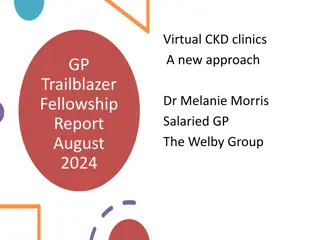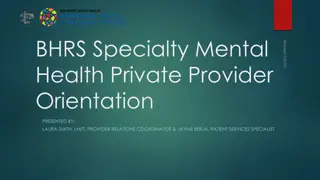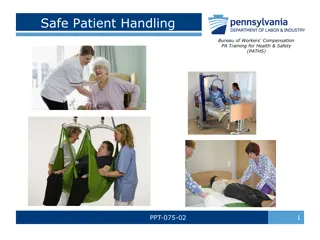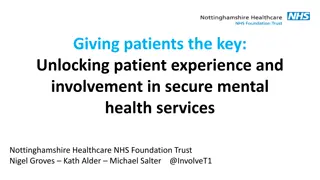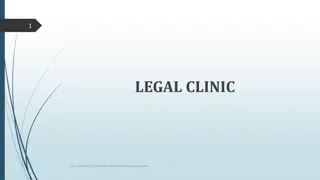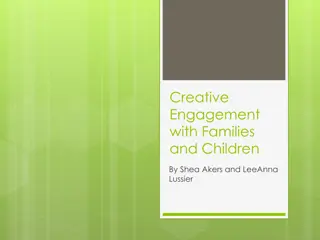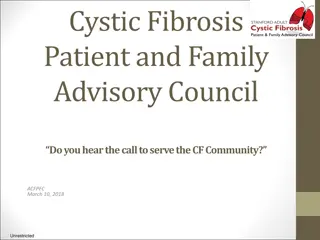Techniques for Building Patient Rapport in O&P Clinics
Explore essential terminology and techniques for enhancing patient rapport in orthotics and prosthetics (O&P) clinics. Learn about treatment planning based on patient diagnosis and assessments, conducting effective patient interviews, and engaging patients through communication strategies. Discover practical tips for handling initial visits and addressing patient concerns to build trust and rapport. Improve your patient interactions and overall quality of care in O&P practice.
Download Presentation

Please find below an Image/Link to download the presentation.
The content on the website is provided AS IS for your information and personal use only. It may not be sold, licensed, or shared on other websites without obtaining consent from the author.If you encounter any issues during the download, it is possible that the publisher has removed the file from their server.
You are allowed to download the files provided on this website for personal or commercial use, subject to the condition that they are used lawfully. All files are the property of their respective owners.
The content on the website is provided AS IS for your information and personal use only. It may not be sold, licensed, or shared on other websites without obtaining consent from the author.
E N D
Presentation Transcript
Module 3 Patient Rapport Addendum Special Thanks to Trulife for the permission to use their content
Terminology & Techniques Terminology & Techniques
Terminology & Techniques Addendum Goal as O&P clinician is to enhance the quality of life for patients Accomplished by developing and implementing a treatment plan that is appropriate for each individual patient
Terminology & Techniques Treatment Plan A treatment plan is based on: Patient s diagnosis Objective information gained in the clinical assessment (measurements) Subjective information gained in the clinical assessment (what the clinician is told)
Terminology & Techniques Patient Interview A good patient interview (or history) is important not only for the information it provides, but also for the opportunity to meet and begin to develop a rapport with our patients.
Terminology & Techniques Initial Visit Patients coming to their initial visit are sometimes: Nervous Apprehensive Scared Angry Emotional and/or confused
Terminology & Techniques Questions The questions for the clinician become: How do I communicate with this patient? How can I develop a rapport and get this patient to trust me?
Terminology & Techniques Communication 5-Es of Communication Engage Empathize Educate Enlist Expectations Jon McKinsey, MD
Terminology & Techniques Engaging the Patient Engaging the Patient: Begins in the front office Staff should be friendly and helpful Patient information forms can distract and help focus the anxious patient Wait times should be as short as possible
Terminology & Techniques Engaging the Patient Continued Engaging the Patient Introduce yourself Be respectful and Use Mr., Mrs. or Ms. Shake their hand and/or pat their shoulder Be conscious of their personal space and/or cultural differences
Terminology & Techniques Addendum Continued Engaging the Patient Be aware of barriers between you and the patient Desk Exam Table Assistive Devices Cell Phones
Terminology & Techniques Posture Engaging the Patient Use good posture Sit level with the patient Face the patient Eye contact Relax
Terminology & Techniques Empathizing Empathizing with the Patient Begins with listening: to what the patient says to how the patient says it to the patient s body language
Terminology & Techniques Empathizing Continued Empathizing with the Patient Use active listening techniques Ask open-ended questions Avoid complex or compound questions Facilitate with silence, gestures and rephrasing Do not interrupt Allow the patient time to tell their story
Terminology & Techniques Building Rapport Empathizing with the Patient Legitimizes the patient s complaints and concerns Builds rapport
Terminology & Techniques Educate the Patient Educate the Patient It is the clinician s responsibility to educate the patient about: Condition O&P treatment options Risks and/or Benefits It is NOT required that the patient agree with the recommendations
Terminology & Techniques Enlist the Patient Enlist the Patient Patients must buy-in Buy-in is enhanced if patients, family and caregivers are enlisted in the treatment making process
Terminology & Techniques Enlist the Patient Continued Enlist the Patient You can enlist patients by: Engaging them in treatment plan Empathizing with their situation Educating them about the treatment plan
Terminology & Techniques Patient Expectations Patient Expectations What does the patient expect: From you? From their condition? As their goals? Expectations must be addressed honestly and in a timely manner
Terminology & Techniques Communication Review Communication Review The patient interview is the first opportunity we have to build a relationship The relationship is as important as the information we gain A good rapport is developed through good communication
Patient History & Treatment Planning
Terminology & Techniques Evaluation Clinical Evaluation and Assessment Principles in O&P Prepared by a task force commissioned by the Directors of ABC Document for use by O&P professionals, consumers and members of the collaborative healthcare team
Terminology & Techniques Responsibilities Roles & Responsibilities Patient Assessment Formulation of the Treatment Plan Implementation of the Treatment Plan Follow-up Treatment Plan Practice Management
Terminology & Techniques Patient Assessment Patient Assessment Reviewing the prescription/referral Taking a comprehensive patient history Performing diagnosis-specific functional clinical exam Consulting healthcare professionals and caregivers Making referrals to other healthcare professionals Documenting assessment in patient record
Terminology & Techniques Patient History Comprehensive Patient History Collection of information from the patient and/or caregiver Some information may be obtained prior to seeing the patient from: Other healthcare professionals Patient medical records Clinic forms and documents
Terminology & Techniques Comprehensive History Comprehensive Patient History Includes: Demographic information Medical history Chief Complaint Past/Present medical history Social history Vocational history Avocational history Orthotic/prosthetic treatment history Reimbursement status
Terminology & Techniques Demographics Comprehensive Patient History Demographics (Patient Characteristics): Name, Address and Phone number Date of Birth/Age Gender Height and Weight Ethnicity and Primary Language Guardian/Caregiver information Dominant side
Terminology & Techniques Medical History Comprehensive Patient History Medical history Signs and Symptoms (Chief Complaints) Medications Allergies Current treatments Past medical history
Terminology & Techniques LOCATES Comprehensive Patient History Use the LOCATES acronym: Location Other symptoms Characteristics Aggravating/Alleviating factors Time factors Environmental factors Severity Jon McKinsey, MD
Other Symptoms Numbness Stiffness Crepitus Falling Stumbling Fear Refusal to stand or walk Limping
Characteristics What does it feel like? Is it numb, achy or painful? Would you describe it as throbbing, burning, stabbing or crushing?
Aggravating/Alleviating Factors What makes it better? Rest Elevation Heat/cold Weight-bearing Medication What makes it worse? Weight-bearing Heat/cold Overuse/fatigue
Timing When did it start? How long does it last? Is it intermittent of continuous? What time of day are the symptoms worse or better?
Environment Where are you at when these symptoms occur or worsen? I m in the car, at the movies or out to dinner. I m usually at work. What are you doing when these symptoms occur or worsen? I m sitting for prolonged periods of time. I m standing on a hard concrete floor for prolonged periods of time.
Severity Quantify the symptoms. On a scale of 0 to 10, with 0 being no pain and 10 being the worse pain you have ever experienced, how would you rate you pain? On a scale of 0 to 10, with 0 being no swelling and 10 being as swollen as your ankle was initially, how swollen is your ankle today.
Terminology & Techniques Social History Comprehensive Patient History Social History Determine Living Conditions Accessibility Devices and equipment needed Determine family/friends supporting recovery Determine transportation condition Determine economic conditions Determine cultural or religious beliefs that could affect treatment
Terminology & Techniques Vocational History Comprehensive Patient History Vocational History Determine patient occupation Assess demands of stated occupation Assess goals of returning to work Assess the importance of work/career to the patient Patient/Family require income
Terminology & Techniques Avocational History Comprehensive Patient History Avocational History Determine what the patient enjoys doing Determine the demands of that activity Assess interest in continuing that activity or possibly a different activity Sometimes more important than work
Terminology & Techniques Treatment History Comprehensive Patient History Orthotic/Prosthetic Treatment History Determine if the patient has had previous O&P treatment Reason (diagnosis) for the O&P treatment? Treatment success or failure? Why? How long prior? How long did it last? Where treatment was performed? Can the patient request a copy of their records?
Terminology & Techniques Reimbursement Status Comprehensive Patient History Reimbursement Status Determine the patient s insurance coverage and benefits Determine the patient s financial responsibilities in any How else might the patient pay for treatment?
Terminology & Techniques Following Patient Assessment Following Patient Assessment Formulation of the Treatment Plan Collaborate with: Patient and Caregivers Physician Other Healthcare providers Dynamic adjust to feedback
Terminology & Techniques Implementation of Plan Implementation of the Treatment Plan Required O&P Intervention Option of Devices Assess Fit and Adjust Donning/Doffing Education (Patient and Caregiver) Verbal and Demonstrations Written if available
Terminology & Techniques Follow Up Plan Follow-up Treatment Plan No set guidelines Observe patient interaction with device Consider other medical factors Neuropathy Arthritis Encourage patient to call with questions/concerns Always try to schedule a follow-up before leaving
Terminology & Techniques Practice Management Practice Management Maintain professional work environment Maintain compliant documentation and patient records More to discuss later in Module 9 concerning facilities management
Terminology & Techniques Review Review The patient medical history is part of the overall patient assessment A comprehensive patient history provides information about the patient and their overall environment Information used helps to formulate and implement a viable treatment plan
Terminology & Techniques References References: Bonewit-West, K. (2000). Clinical Procedures for Medical Assistants. Philadelphia: Saunders. McDonald, E. (Ed). (2004). Difficult Conversations in Medicine. New York: Oxford University Press. McKinsey, J. The Medical Interview. Retrieved August 21, 2006. Billock, J. (1996). Clinical Evaluation and Assessment Principles in Orthotics and Prosthetics, JPO, 8(2), 41 to 46. Retrieved August 31, 2006.
Terminology & Techniques Thank you.
Pedorthic Program of Study This workforce product was funded by a grant awarded by the U.S. Department of Labor s Employment and Training Administration. The product was created by the grantee and does not necessarily reflect the official position of the U.S. Department of Labor. The U.S. Department of Labor makes no guarantees, warranties, or assurances of any kind, express or implied, with respect to such information, including any information on linked sites and including, but not limited to, accuracy of the information or its completeness, timeliness, usefulness, adequacy, continued availability, or ownership. Produced 2016. HOPE Careers Consortium is a partnership of five institutions of higher education that is building exciting new programs that will provide valuable career education and training in the Orthotics, Prosthetics, and Pedorthics (O&P) sector. The five institutions are: Baker College Flint, Michigan; Century College White Bear Lake, Minnesota; Oklahoma State University Institute of Technology Okmulgee, Oklahoma; Spokane Falls Community College Spokane, Washington; and St. Petersburg College St. Petersburg, Florida. Although the authoring institution of this educational resource has made every effort to ensure that the information presented is correct, the institution assumes no liability to any party for any loss, damage, or disruption caused by errors or omissions. Except where otherwise noted, this work by St. Petersburg College is licensed under the Creative Commons Attribution 4.0 International License. To view a copy of this license, click on the following link: Creative Commons Licenses 4.0.



